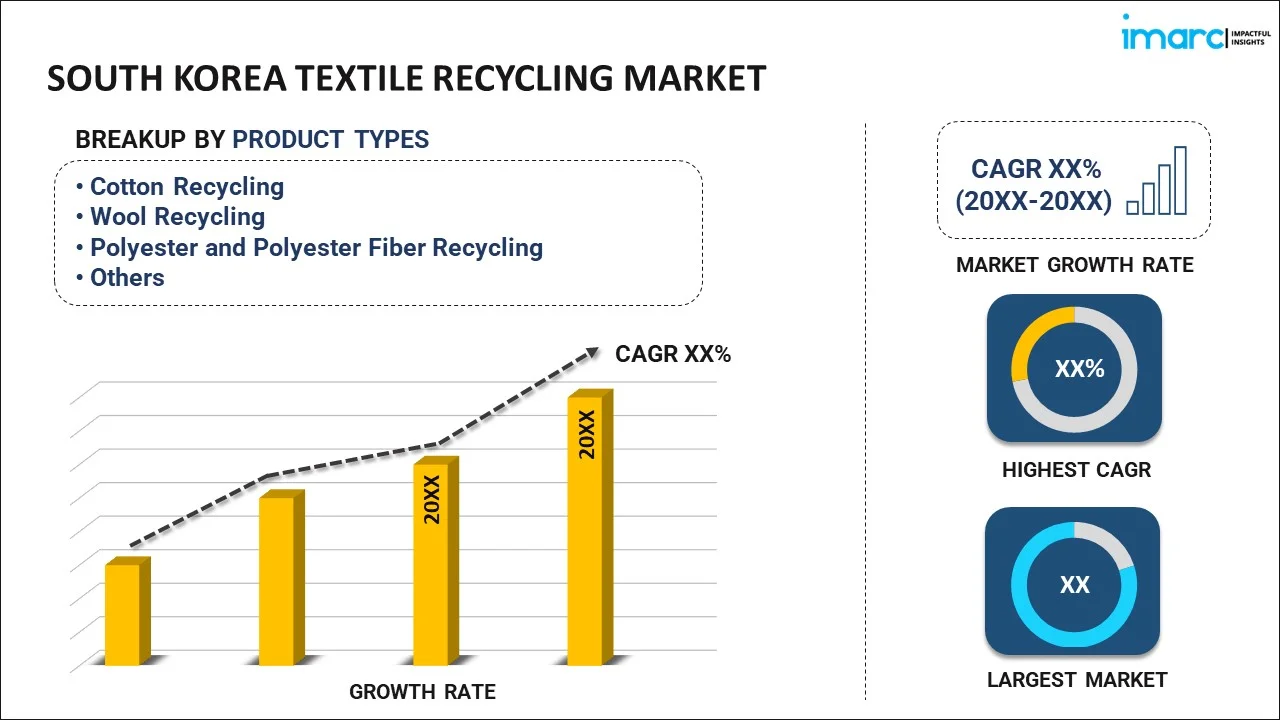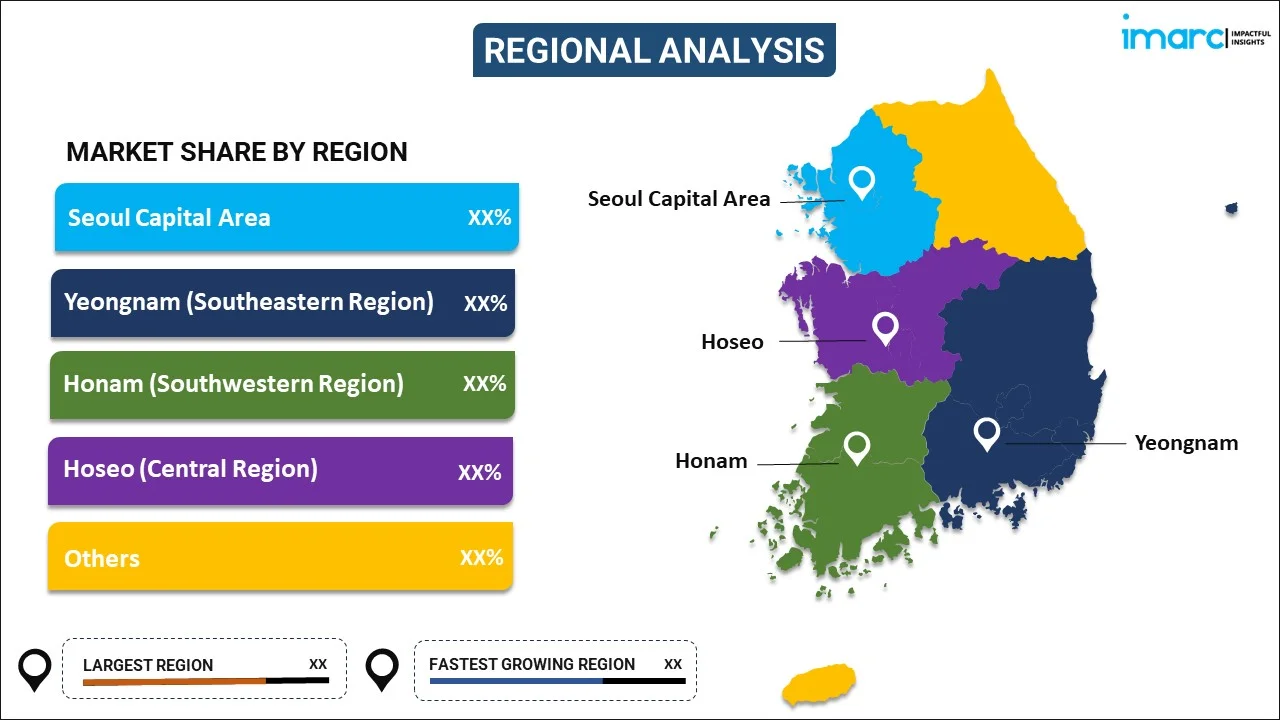
South Korea Textile Recycling Market Report by Product Type (Cotton Recycling, Wool Recycling, Polyester and Polyester Fiber Recycling, Nylon and Nylon Fiber Recycling, and Others), Textile Waste (Pre-consumer Textile, Post-consumer Textile), Distribution Channel (Online Channel, Retail and Departmental Store), End User (Apparel, Industrial, Home Furnishings, Non-Woven, and Others), and Region 2024-2032
Market Overview:
South Korea textile recycling market size is projected to exhibit a growth rate (CAGR) of 4.77% during 2024-2032. The rising awareness among the masses in South Korea about growing environmental issues, continuous innovations in textile recycling technologies, and the integration of technology, such as IoT-enabled clothing tracking and smart textiles, represent some of the key factors driving the market.
|
Report Attribute
|
Key Statistics
|
|---|---|
|
Base Year
|
2023 |
|
Forecast Years
|
2024-2032
|
|
Historical Years
|
2018-2023
|
| Market Growth Rate (2024-2032) | 4.77% |
Textile recycling refers to the collection and processing of used textiles, including clothing, fabrics, and other textile products, for repurposing them into new materials or products. It involves mechanical processes like shredding or cutting textiles into smaller pieces or chemical processes to break down fibers and remove contaminants. It encompasses a wide range of materials, such as cotton, polyester, wool, and blends. It helps minimize textile waste in landfills and contributes to environmental conservation by reducing the need for virgin textile production, which consumes vast amounts of water and energy while emitting greenhouse gases (GHGs). Besides this, it reduces the demand for new textile production and conserves water resources, helping to alleviate water scarcity issues in certain regions. Moreover, as it can eliminate the need for chemicals used in textile production, such as pesticides and dyes, the demand for textile recycling is increasing across South Korea.
South Korea Textile Recycling Market Trends:
The rising awareness among the masses in South Korea about growing environmental issues, such as textile waste and resource depletion, represents one of the primary factors catalyzing the demand for sustainable practices like textile recycling. Additionally, the increasing consciousness among individuals about the environmental impact of their clothing choices is driving the demand for sustainable and recycled textiles. Along with this, the rising shift toward a circular economy is driving investment in recycling infrastructure, including textile recycling, to keep materials in use for longer. Furthermore, several South Korean companies and municipalities are setting targets to reduce textile waste, encouraging recycling efforts. Moreover, the governing authorities of the country are introducing numerous regulations and policies to promote recycling and waste reduction, creating a favorable environment for textile recycling initiatives. Besides this, many South Korean fashion brands are embracing sustainability and incorporating recycled textiles into their collections to meet consumer demand. In addition, initiatives like clothing donation bins and take-back programs in retail stores are increasing the availability of textiles for recycling. Furthermore, continuous innovations in textile recycling technologies are making the process more efficient and cost-effective. Moreover, the rising collaborations between textile manufacturers, recyclers, and fashion brands are fostering a more sustainable textile ecosystem. Along with this, the growing concerns among people in South Korea about resource scarcity, such as water and cotton, are encouraging the adoption of recycling. Additionally, rapid advancements in technology are enabling textile-to-textile recycling, which is reducing the need for virgin materials. The integration of technology, such as IoT-enabled clothing tracking and smart textiles, is creating opportunities for efficient and traceable recycling processes, enhancing the appeal of textile recycling as a high-tech and data-driven industry.
South Korea Textile Recycling Market Segmentation:
IMARC Group provides an analysis of the key trends in each segment of the market, along with forecasts at the country level for 2024-2032. Our report has categorized the market based on product type, textile waste, distribution channel, and end user.
Product Type Insights:

- Cotton Recycling
- Wool Recycling
- Polyester and Polyester Fiber Recycling
- Nylon and Nylon Fiber Recycling
- Others
The report has provided a detailed breakup and analysis of the market based on the product type. This includes cotton recycling, wool recycling, polyester and polyester fiber recycling, nylon and nylon fiber recycling, and others.
Textile Waste Insights:
- Pre-consumer Textile
- Post-consumer Textile
A detailed breakup and analysis of the market based on the textile waste have also been provided in the report. This includes pre-consumer textile and post-consumer textile.
Distribution Channel Insights:
- Online Channel
- Retail and Departmental Store
The report has provided a detailed breakup and analysis of the market based on the distribution channel. This includes online channel and retail and departmental store.
End User Insights:
- Apparel
- Industrial
- Home Furnishings
- Non-Woven
- Others
A detailed breakup and analysis of the market based on the end user have also been provided in the report. This includes apparel, industrial, home furnishings, non-woven, and others.
Regional Insights:

- Seoul Capital Area
- Yeongnam (Southeastern Region)
- Honam (Southwestern Region)
- Hoseo (Central Region)
- Others
The report has also provided a comprehensive analysis of all the major regional markets, which include Seoul Capital Area, Yeongnam (Southeastern Region), Honam (Southwestern Region), Hoseo (Central Region) and Others.
Competitive Landscape:
The market research report has also provided a comprehensive analysis of the competitive landscape. Competitive analysis such as market structure, key player positioning, top winning strategies, competitive dashboard, and company evaluation quadrant has been covered in the report. Also, detailed profiles of all major companies have been provided.
South Korea Textile Recycling Market Report Coverage:
| Report Features | Details |
|---|---|
| Base Year of the Analysis | 2023 |
| Historical Period | 2018-2023 |
| Forecast Period | 2024-2032 |
| Units | US$ Million |
| Scope of the Report | Exploration of Historical and Forecast Trends, Industry Catalysts and Challenges, Segment-Wise Historical and Predictive Market Assessment:
|
| Product Types Covered | Cotton Recycling, Wool Recycling, Polyester and Polyester Fiber Recycling, Nylon and Nylon Fiber Recycling, Others |
| Textile Wastes Covered | Pre-consumer Textile, Post-consumer Textile |
| Distribution Channels Covered | Online Channel, Retail and Departmental Store |
| End Users Covered | Apparel, Industrial, Home Furnishings, Non-Woven, Others |
| Regions Covered | Seoul Capital Area, Yeongnam (Southeastern Region), Honam (Southwestern Region), Hoseo (Central Region), Others |
| Customization Scope | 10% Free Customization |
| Report Price and Purchase Option | Single User License: US$ 3699 Five User License: US$ 4699 Corporate License: US$ 5699 |
| Post-Sale Analyst Support | 10-12 Weeks |
| Delivery Format | PDF and Excel through Email (We can also provide the editable version of the report in PPT/Word format on special request) |
Key Questions Answered in This Report:
- How has the South Korea textile recycling market performed so far and how will it perform in the coming years?
- What has been the impact of COVID-19 on the South Korea textile recycling market?
- What is the breakup of the South Korea textile recycling market on the basis of product type?
- What is the breakup of the South Korea textile recycling market on the basis of textile waste?
- What is the breakup of the South Korea textile recycling market on the basis of distribution channel?
- What is the breakup of the South Korea textile recycling market on the basis of end user?
- What are the various stages in the value chain of the South Korea textile recycling market?
- What are the key driving factors and challenges in the South Korea textile recycling?
- What is the structure of the South Korea textile recycling market and who are the key players?
- What is the degree of competition in the South Korea textile recycling market?
Key Benefits for Stakeholders:
- IMARC’s industry report offers a comprehensive quantitative analysis of various market segments, historical and current market trends, market forecasts, and dynamics of the South Korea textile recycling market from 2018-2032.
- The research report provides the latest information on the market drivers, challenges, and opportunities in the South Korea textile recycling market.
- Porter's five forces analysis assist stakeholders in assessing the impact of new entrants, competitive rivalry, supplier power, buyer power, and the threat of substitution. It helps stakeholders to analyze the level of competition within the South Korea textile recycling industry and its attractiveness.
- Competitive landscape allows stakeholders to understand their competitive environment and provides an insight into the current positions of key players in the market.
Need more help?
- Speak to our experienced analysts for insights on the current market scenarios.
- Include additional segments and countries to customize the report as per your requirement.
- Gain an unparalleled competitive advantage in your domain by understanding how to utilize the report and positively impacting your operations and revenue.
- For further assistance, please connect with our analysts.
 Inquire Before Buying
Inquire Before Buying
 Speak to an Analyst
Speak to an Analyst
 Request Brochure
Request Brochure
 Request Customization
Request Customization




.webp)




.webp)












